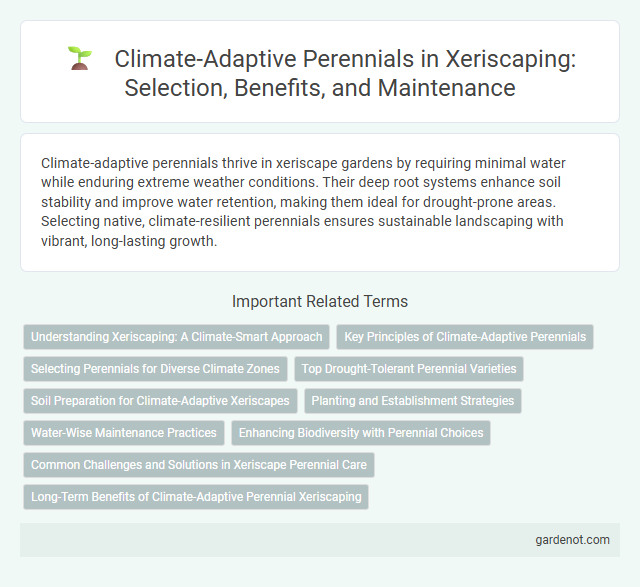Climate-adaptive perennials thrive in xeriscape gardens by requiring minimal water while enduring extreme weather conditions. Their deep root systems enhance soil stability and improve water retention, making them ideal for drought-prone areas. Selecting native, climate-resilient perennials ensures sustainable landscaping with vibrant, long-lasting growth.
Understanding Xeriscaping: A Climate-Smart Approach
Climate-adaptive perennials are essential in xeriscaping, offering drought resistance and low water requirements that align with sustainable landscaping practices. These plants, such as lavender, yarrow, and sedum, thrive in arid environments by efficiently utilizing limited water resources and reducing irrigation needs. Incorporating climate-adaptive perennials supports water conservation efforts while enhancing soil health and biodiversity in xeriscaped gardens.
Key Principles of Climate-Adaptive Perennials
Climate-adaptive perennials thrive by selecting drought-tolerant species that require minimal irrigation, enhancing water conservation in xeriscapes. Their deep root systems improve soil structure and promote efficient moisture retention, reducing dependency on supplemental watering. Incorporating native plants adapted to local climate zones ensures ecosystem resilience and supports biodiversity in arid landscapes.
Selecting Perennials for Diverse Climate Zones
Selecting climate-adaptive perennials for xeriscape gardening involves choosing drought-tolerant species that thrive in varied climate zones, from arid deserts to temperate regions. Key options include Echinacea purpurea for its heat endurance, Sedum species for low water needs, and Salvia varieties that attract pollinators while withstanding dry conditions. Integrating these resilient perennials optimizes water conservation and enhances landscape sustainability across diverse environmental settings.
Top Drought-Tolerant Perennial Varieties
Top drought-tolerant perennial varieties such as Lavender (Lavandula), Yarrow (Achillea), and Russian Sage (Perovskia atriplicifolia) excel in xeriscape gardens for their ability to thrive with minimal water. These climate-adaptive perennials offer resilient foliage and extended bloom periods, reducing irrigation needs while supporting local pollinators. Selecting species with deep root systems and heat tolerance enhances sustainability in arid landscapes.
Soil Preparation for Climate-Adaptive Xeriscapes
Soil preparation for climate-adaptive xeriscapes involves amending soil with organic matter to enhance water retention and improve drainage for climate-adaptive perennials. Testing soil pH and nutrient levels ensures optimal growth conditions, while creating mulch layers reduces evaporation and supports soil moisture conservation. Selecting soil mixes tailored to drought-tolerant plants promotes resilience in arid and variable climates.
Planting and Establishment Strategies
Climate-adaptive perennials in xeriscape landscaping require strategic planting techniques such as selecting drought-tolerant species compatible with local soil and microclimate conditions. Establishment strategies emphasize deep watering at planting to encourage deep root growth, minimizing irrigation while maximizing resilience. Mulching and soil amendments further retain moisture, reduce evaporation, and support long-term plant health in arid environments.
Water-Wise Maintenance Practices
Climate-adaptive perennials, such as lavender, Russian sage, and yarrow, thrive in xeriscape gardens by requiring minimal irrigation and adapting to drought-prone conditions. Implementing water-wise maintenance practices like deep, infrequent watering and mulching helps retain soil moisture, reduces evaporation, and enhances root development for these resilient plants. Strategic pruning and soil enrichment further boost plant health while conserving water in arid landscapes.
Enhancing Biodiversity with Perennial Choices
Climate-adaptive perennials play a crucial role in xeriscape gardens by supporting local ecosystems and enhancing biodiversity. Selecting native and drought-tolerant species such as Echinacea purpurea, Salvia nemorosa, and Asclepias tuberosa provides food and habitat for pollinators, birds, and beneficial insects. Incorporating a variety of perennial plants with staggered bloom times ensures continuous ecological support throughout the growing season.
Common Challenges and Solutions in Xeriscape Perennial Care
Climate-adaptive perennials in xeriscape gardens often face challenges such as inconsistent watering, soil nutrient deficiencies, and extreme temperature fluctuations. Implementing deep, infrequent watering schedules helps roots develop resilience, while incorporating organic matter and mulch improves soil structure and moisture retention. Selecting drought-tolerant species like lavender, yarrow, and Russian sage reduces maintenance and enhances long-term garden sustainability.
Long-Term Benefits of Climate-Adaptive Perennial Xeriscaping
Climate-adaptive perennial xeriscaping enhances water efficiency by using deep-rooted plants specifically suited to arid conditions, drastically reducing irrigation needs over time. These resilient perennials improve soil health and biodiversity while minimizing maintenance and replacement costs, delivering sustained environmental and economic benefits. Integrating native climate-resilient perennials supports long-term landscape stability amid increasing drought frequency and temperature fluctuations.
Climate-adaptive perennial Infographic

 gardenot.com
gardenot.com